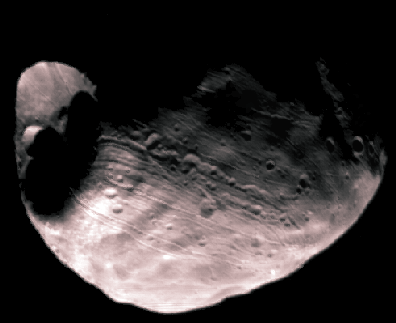
|
Explanation: Phobos is doomed. Mars, the red planet named for the Roman god of war, has two tiny moons, Phobos and Deimos, whose names are derived from the Greek for Fear and Panic. These Martian moons may well be captured asteroids originating in the asteroid belt between Mars and Jupiter or perhaps from even more distant reaches of the Solar System. In this 1977 Viking orbiter image, the largest moon, Phobos, is seen to be a heavily cratered asteroid-like object. It is about 17 miles across and zips through the Martian sky completing an orbit in less than 8 hours. Phobos orbits so close to Mars, (about 3,600 miles above the surface compared to 250,000 miles for our Moon) that gravitational tidal forces are dragging it down. In 100 million years or so it should crash into the surface or be shattered by stress caused by the relentless tidal forces, the debris forming a ring around Mars.
|
January February March April May June July August September October November December |
| ||||||||||||||||||||||||||||||||||||||||||||||||
NASA Web Site Statements, Warnings, and Disclaimers
NASA Official: Jay Norris. Specific rights apply.
A service of: LHEA at NASA / GSFC
& Michigan Tech. U.
Based on Astronomy Picture
Of the Day
Publications with keywords: Mars - Phobos
Publications with words: Mars - Phobos
See also:
- APOD: 2025 September 28 B Leopard Spots on Martian Rocks
- APOD: 2025 July 15 B Collapse in Hebes Chasma on Mars
- APOD: 2025 July 6 B The Spiral North Pole of Mars
- APOD: 2025 June 29 B Dark Sand Cascades on Mars
- APOD: 2025 June 22 B A Berry Bowl of Martian Spherules
- APOD: 2025 June 15 B Two Worlds One Sun
- Perseverance Selfie with Ingenuity
